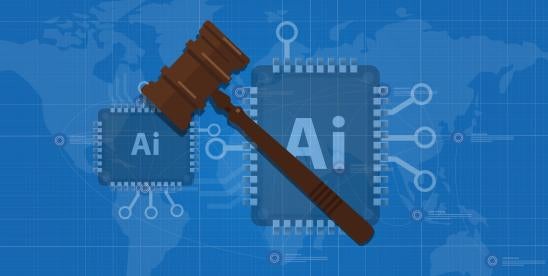Much like word processing with spell check and other now commonplace digital tools were once only the stuff of science fiction, artificial intelligence (AI) is quickly becoming widespread in knowledge work including law practice. IP law is no exception. The use of AI in IP law practice has practical benefits, including the potential for enhanced efficiency and lower costs in drafting and prosecuting patents before the U.S. Patent and Trademark Office (USPTO). The USPTO has expressed support for the good that can come from the use of AI in the legal profession, while also warning about the problems that its use can create. Indeed, incentivizing and protecting AI innovation is one of the top priorities and a major initiative of the USPTO, along with the Council for Inclusive Innovation (CI2), Empowering Women’s Entrepreneurship (WE), and others. The USPTO’s recently issued notice of rulemaking is an important step toward avoiding perils and alleviating fears about the use of AI when practicing before the Office.
The USPTO’s AI Guidance for Practitioners
Just two months after issuing its Inventorship Guidance for AI-assisted inventions, discussed in our prior blog here, the USPTO made good on its promise to issue Practice Guidance concerning the USPTO’s existing rules and their applicability to the use of AI tools.
In its Practice Guidance, the Office takes the stance that the existing rules are adequate to address the challenges posed by AI when it comes to its usage and how parties and practitioners should use AI tools. Rather than issuing a new set of AI-specific rules, the Practice Guidance offers clarity as to how existing rules apply when using AI technologies in dealings before the USPTO.
Interestingly, the Office makes clear that there is no specific duty for parties and practitioners to disclose that they use AI tools in filing any paper including a patent application before the USPTO. Applicants cannot, however, rely on the accuracy of AI in drafting a document without a natural person verifying the content of that document. Instead, the Office insists that if anything is inaccurate in a disclosure it is the applicant’s and their attorney’s responsibility to verify ahead of time or correct the record if a mistake is later discovered. Additionally, because of the signature requirement for most papers filed before the USPTO, a natural or real person is required to verify the accurateness or veracity of any statement made within them. This includes statements on inventorship, the inventor’s oath, responses to office actions in patent and trademark cases, and the like.
AI-based solutions that can create content, author legal research memos, perform due diligence analysis, extract legal principles contained in court opinions, and assist in deposition preparation, also have the potential to make prior art searches, claim charting, and document reviews easier while practicing before the USPTO. Just like any other digital tool, human verification of the outputs of AI tools is necessary. The USPTO openly admits that even USPTO examiners are using AI tools in performing prior art searches using features like “More Like This Document” (MLTD) and “Similarity Search” in the Office’s Patents End-to-End (PE2E) Search tool.
While not meant to be exhaustive, the Practice Guidance highlights several areas where the existing rules apply to AI-related technologies used before the USPTO, and explains how the Office will interpret those rules to reprove AI-related misconduct by patent practitioners and applicants. These areas include:
- the duty of candor and good faith, including a duty to disclose to the Office all information known to that individual to be material to patentability;
- the signature requirement attesting to the veracity of the statements made in the submission;
- the requirement that practitioners maintain the confidentiality of client information;
- the requirement for foreign filing licenses and compliance with Export Administration Regulations (EAR);
- the terms and conditions of use of USPTO electronic systems; and
- the duty of competent and diligent representation owed to a client.
It is easy to imagine a day when tools that include the ability to draft technical specifications, generate responses to Office Actions, write and respond to briefs, and even draft patent claims will be commonplace. “[T]here is no prohibition against using these computer tools in drafting documents for submission to the USPTO. Nor is there a general obligation to disclose to the USPTO the use of such tools.”
The Practice Guidance notes, however, that in presenting an AI-drafted paper to the Office, as with any other paper, the presenter certifies under 37 CFR 11.18(b) that all statements in the paper are true and that the presenter performed a reasonable inquiry to verify the accuracy. Obviously, reasonable inquiry requires review and verification of the paper and its contents —simply relying on the accuracy of an AI tool is not a reasonable inquiry. As stated in the Practice Guidance, the USPTO will hold parties accountable to this standard. Penalties for failure to meet the standard could include striking the offending paper, referring the practitioner’s conduct to the Director of the Office of Enrollment and Discipline, or terminating the proceedings in the Office.
The Practice Guidance provides an example in which an AI system is used to draft patent claims that are submitted for examination, and the system introduces alternative embodiments that the inventor did not conceive or to which a human inventor did not make a significant contribution. If the applicant seeks to patent such embodiments, then the AI system’s contribution is material to patentability and must be disclosed to the Office.
For at least these reasons, the Practice Guidance stresses the need for practitioner review of applications prepared with the assistance of AI, before filing — to see that information is not incorrectly or incompletely characterized, to verify the accuracy of factual assertions, both technical and legal, and to ensure that all documents, including those prepared with the assistance of AI, do not introduce inaccurate statements and evidence into the record, either inadvertently or intentionally, or omit information that is material to patentability.
Takeaways
As AI tools become more and more prevalent in patent practice, it will not be practical or helpful for every practitioner to disclose the use of AI-related tools for every paper that is filed. The Guidance provides a useful reminder about the duties of candor and good faith, as well as a warning, to practitioners and applicants alike, to exercise special care when using AI as a tool in papers submitted to the USPTO. As the use of these tools becomes more pervasive, it will be necessary to continue to monitor new situations as they emerge, at which point well thought-out and vetted rules specific to AI will be welcome.
The USPTO should be applauded for keeping its ear to the ground and partnering with the IP community to remain aware of the realistic application of AI tools. Please watch this space for further USPTO AI-related updates.





 i
i


